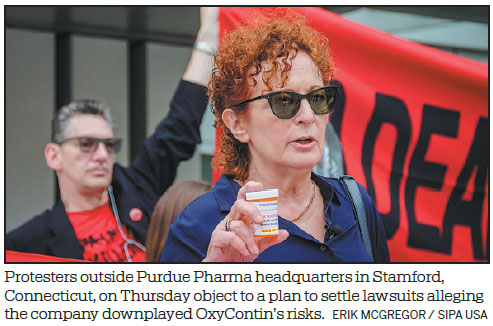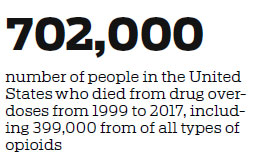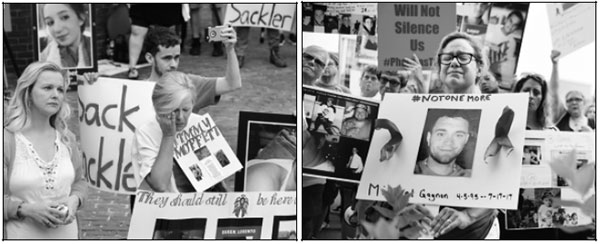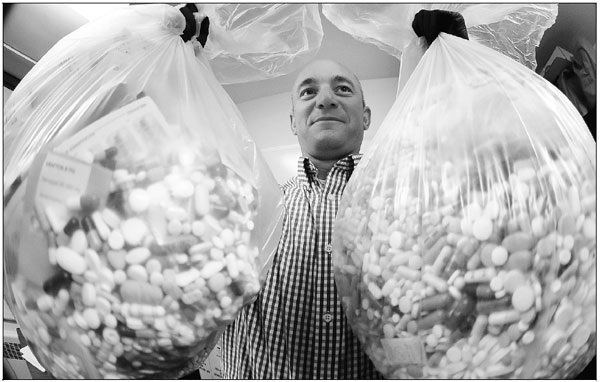Opioid epidemic has the US in its grip
Lawsuits allege wealthy family put profits before health
On a bleak February day with slate-gray skies and temperatures below freezing, individuals, couples and groups, ranging in age from teenagers to retirees, gathered in New York at the Guggenheim Museum on Fifth Avenue in Manhattan, opposite Central Park.
They walked quietly, spreading to all floors of the museum before falling to the ground.
They quickly covered the floors with white paper - mock drug prescriptions for"80 milligram pills of OxyContin" written by "Robert Sackler, MD" for "Solomon R. Guggenheim" (who established the museum) to be taken "24 times a day". Empty orange medicine bottles soon added to the clutter.

|
Left and right: Protesters who have lost loved ones to OxyContin and opioid overdoses protest at Purdue Pharma's headquarters in Stamford, Connecticut. Jessica Hill, File / AP |
|
Narcotics detective Ben Hill, with the Barberton Police Department in Pennsylvania, shows two bags of medication that are slated for destruction at the department's headquarters. Keith Srakocic / AP |
The Sackler family made its fortune through the sale of OxyContin - a potent and legal opioid painkiller approved by the United States Food and Drug Administration - and has donated millions of dollars to museums.
Purdue Pharma, owned by the Sackler family, faces more than 2,000 lawsuits, including actions from nearly all US states and many local governments, which allege the company falsely promoted OxyContin by downplaying the risk of addiction.
The company filed for bankruptcy on Sunday night in White Plains, New York, and announced a $10 billion plan to settle the lawsuits.
Under the proposed settlement, which is backed by about half the states and thousands of local governments that are suing Purdue, the Sacklers will hand the company's assets over to a trust controlled by those states, cities and counties. Money generated by the reformed company will be used for drug treatment.

The Sacklers are one of the richest families in the US, with an estimated net worth of $13 billion, according to Forbes magazine.
On Friday, the New York State Attorney General's Office said it had tracked about $1 billion in wire transfers by the Sacklers, including through Swiss bank accounts, suggesting that the family tried to shield its wealth as it faced the lawsuits.
Before Sunday, 27 US states and 2,000 cities and counties had agreed to the settlement, but at least 20 states had refused.
The lawsuits allege that Purdue Pharma, based in Stamford, Connecticut, put profit above health by aggressively marketing OxyContin, the brand name for oxycodone, knowing it could lead to addiction and death by overdose.
From 1999 to 2017, some 702,000 people in the US died from drug overdoses, including 399,000 from of all types of opioids, including oxycodone, heroin and synthetics such as fentanyl. In 2017, 68 percent of the 70,000 people who died from a drug overdose, or 47,600, were killed by a prescribed or illicit opioid, according to the US Centers for Disease Control, or CDC.
The settlement
Despite the tentative settlement, litigation against Purdue Pharma appears likely to continue. However, the tentative deal and the bankruptcy filing by the company will end the need for the first federal trial involving the opioid epidemic, which was scheduled to start next month in Ohio.
The lawsuits have been consolidated through US District Court Judge Dan Polster in Cleveland. He urged the parties to settle and invited state attorneys general to take an active role in the negotiations.
The tentative deal includes about $3 billion from the Sackler family's fortune. Another $1.5 billion could be added depending on the amount raised from the sale of Mundipharma, a company the family also owns that sells drugs outside the US. The Sacklers would give up their interest in the company and it would be converted to a for-profit trust.
Those backing the proposed settlement said it is a good way to ensure compensation from Purdue Pharma and the Sacklers because the company could file for bankruptcy on its own, clouding future payouts. Other plaintiffs said the offer is too small to adequately compensate those harmed by OxyContin.
Attorneys general in some states in the US are concerned about the value of a settlement involving Purdue Pharma because a portion of the money would come from future sales of OxyContin and products under development. In short, it is a paradox - future payouts would depend on the continued sale of a drug detested by state attorneys general.
In a statement, the Sacklers supported the tentative settlement, calling it "the most effective way to address the urgency of the current public health crisis and to fund real solutions, not endless litigation".
In Los Angeles, Ryan Hampton, an advocate for people recovering from opioid addiction, urged those harmed by the drug to reject the deal.
"The amount of money that's being offered in this settlement doesn't even scratch the surface for what's needed," Hampton told The Associated Press. "We want to see Purdue have their day in court. We know more money will come if this case goes to trial."
Who is responsible?
Doctors, politicians, law enforcement officials and parents of those who have died ask the same questions: Who is responsible for the opioid epidemic? Does it represent an individual failure or a fatal flaw in US healthcare?
There is no easy answer.
OxyContin requires a doctor's prescription. While doctors running "pill mills" have written fraudulent prescriptions for vast quantities of OxyContin, is the maker of the drug responsible for its misuse any more than the manufacturer and marketer of an automobile involved in a hit-and-run accident or terrorist attack liable for the carnage caused?
Judges have said the manufacturer is responsible, and companies making opioids are apparently eager to settle the lawsuits.
Purdue Pharma offered to settle a case filed by Oklahoma in a state court for $270 million, a proposal that would have included $200 million for a new center at Oklahoma State University to study and treat opioid addiction.
Last month, an Oklahoma judge ruled in a similar case that rival company Johnson& Johnson must pay $572 million for its aggressive sales tactics related to opioids. The company said it would appeal the judge's ruling to a higher court. Oklahoma Attorney General Mike Hunter, a Republican, is now focusing on a $17 billion claim that the company "abate" the "public nuisance" caused by opioid addiction, an argument that could easily be extended to Purdue Pharma and other drugmakers.
According to some legal arguments, Hunter is seeking to push public nuisance law beyond its intended purpose of cleaning up trash-filled vacant lots, fixing smelly factories, or limiting excessive noise. New York City and Oakland, California, unsuccessfully attempted to use public nuisance law to force oil companies to pay for damage they alleged would be caused by future climate change resulting from burning fossil fuels.
Unlike product liability lawsuits, public nuisance cases do not require evidence of a direct link between the alleged nuisance and its effect. A company can be found liable if it is "unlaw fully doing an act, or omitting to perform a duty", according to websites on which the law is being discussed.

In his decision, Oklahoma State Judge Thad Balkman said Johnson & Johnson acted unlawfully by relying on "misleading marketing" designed to "influence doctors" and "governmental agencies" while "optimizing the benefits of prescription opioids for pain management and minimizing their risks".
The judge made no link between doctors, prescriptions, pharmacies and those who became addicted or died.
Private attorneys who helped the Oklahoma attorney general prepare the case have already been awarded $60 million, according to news reports.
In a related case, Allergan, based in Dublin, the Irish capital, agreed to pay $5 million to settle its portion of a federal opioid case scheduled to begin next month. The company agreed to pay $1.9 million to Summit County, Ohio, and $3.1 million to Cuyahoga County, also in Ohio. The claims were selected to serve as bellwethers in opioid litigation, according to media reports.
Misuse cases
OxyContin is a prescription opioid pain reliever. First synthesized in 1916, the drug wasn't available in the US until 1939. It is a time-released formula of oxycodone and provides up to 12 hours' relief to patients experiencing chronic pain from surgery, cancer, injury or severe arthritis.
Oxycodone creates a euphoric high and this can lead users with a prescription to obtain more of the drug than they need, and others to obtain it illegally. It is used in other medications, including Percocet, a mixture of oxycodone and acetaminophen. The latter drug, available without a prescription, is an analgesic used to treat headaches or fever and as an alternative to aspirin, according to medical websites.
The CDC said the use of opioid painkillers in the US rose steadily from 2006, peaking in 2012 at more than 255 million prescriptions - a rate of 81.3 per 100 people. The overall rate of prescribing oxycodone fell from 2012 to 2017, the most recent year in which comprehensive data was collected, dropping to 191 million prescriptions, or 58.7 per 100 people. Still, the federal agency estimated the cost of prescription opioid misuse at $78.5 billion a year, including the cost of healthcare, lost productivity, addiction treatment and law enforcement.
In the US, the use of oxycodone varies by region. Prescription painkiller sales per person are about three times higher in Florida, which has the highest usage rate nationwide and a large population of retirees, compared with Illinois, which has the lowest rate of use.
More men than women die from overdoses of prescription painkillers, and middle-aged adults have the highest rate, although deaths occur among teenagers and young adults who illegally obtain the drug and use it recreationally without a prescription.
The number of people abusing opioids is lower in rural areas, but the death rate is higher than in cities. This disparity appears to be related to the proximity of emergency care. Whites, Native Americans or Alaska Natives are more likely to overdose than other groups, the CDC said.
In 2017, the areas with the highest death rates due to drug overdoses included West Virginia, Pennsylvania, Kentucky and Washington, the capital, the CDC reported.
The high obtained from opioids is sometimes compared with heroin, an illegal and highly addictive drug made from the resin of poppies. Heroin was first manufactured in 1898 and marketed as a treatment for tuberculosis and as a cure for morphine addiction.
Proper use of OxyContin does not necessarily lead to addiction. Those who abuse it frequently develop a tolerance and increase the dosage or mix it with other drugs to achieve the same effect. This increases the risk of overdosing and death, health officials warn.
Unintended consequences
The Cato Institute, a think tank in Washington, argues that efforts by law enforcers to curb illegal street-level use of OxyContin have produced unexpected and undesired results.
Initially, opioid therapy was limited to terminally ill cancer patients, but use of powerful painkillers was extended to those with chronic or acute pain. Many doctors, medical boards and law enforcement officials were wary because the drugs can be habit-forming. Wider use increased the danger of misuse and addiction, they said.
The problem worsened when OxyContin began to be sold on the black market. The US Drug Enforcement Agency used tactics developed to combat the illegal sale of cocaine and other drugs to fight black-market sales of OxyContin - undercover investigations, informers, arrests and asset seizure.
The Cato Institute said in a research paper: "The DEA's painkiller campaign has cast a chill over the doctor-patient candor necessary for successful treatment. It has also scared many doctors out of pain management altogether, and likely persuaded others not to enter it, thus worsening the already widespread problem of underrated, untreated chronic pain."
Making OxyContin pills crushproof so the powder could not be inhaled to get high led to increased heroin use. The narcotic is frequently injected intravenously and users often share needles. This has led to an increase in hepatitis and HIV infection, Cato Institute researchers said.
The US attorney for the Southern District of New York said a 30-mg oxycodone tablet has a street value of $20 to $30. At the high end of the range, a prescription for 120 tablets would net $3,600 in illegal sales of the drug. Some doctors have seen this as an easy source of tax-free cash.
In July, Ernesto Lopez, 76, was sentenced to five years in prison after being convicted of writing thousands of medically unnecessary prescriptions for oxycodone and fentanyl over three years. When arrested, Lopez had $729,000 in cash at his home in Queens, New York. He was fined $50,000 and ordered to forfeit $1.4 million from his "pill mill" operation.
Martin Tesher, 83, was convicted of prescribing oxycodone pills and other opioids from his office on Manhattan's exclusive Upper East Side and sentenced to 20 years in prison. A 27-year-old man with no apparent need for the drug died after Tesher illegally prescribed oxycodone, authorities said.
"Patients came to him at their most vulnerable," federal prosecutor Jennifer Sasso said at the sentencing hearing in April. "He did what a common drug dealer would do - he filled them with pills, an astronomical number of pills."
In Florida, Barry Schultz was sentenced to 157 years in prison in August last year after he prescribed and sold large quantities of medically unnecessary opioids.
scottreeves@chinadailyusa.com
Purdue Pharma, created by three brothers, not required to disclose finances
Purdue Pharma was established by three brothers from the Sackler family in 1952 after they took over a small drug manufacturer in Greenwich Village, New York.
Arthur Sackler died in 1987 age 73, Mortimer Sackler in 2010 at age 93 and Raymond Sackler in 2017 at 97.
About 20 family members now share the wealth created by the drug company. Purdue Pharma is privately held and, unlike publicly traded companies, is not required to disclose its finances.
Mortimer and Raymond bought Arthur's share of the company after he died. Arthur's heirs have not been active in the company since then.
Soon after it was established, Purdue Pharma developed successful - but not blockbuster - products such as earwax remover and laxatives. The company remained relatively unknown until 1995, when it launched OxyContin, an opioid pain reliever. By 2003, sales totaled about $1.6 billion a year.
According to The Wall Street Journal, the family now nets about $4 billion a year from sales of OxyContin.
The family donates to museums and universities. Arthur Sackler, who initially handled marketing, later became one of the world's top collectors of Asian art.
|
Left: Narcotics detective Paul Laurella retrieves unused medication from the police department's disposal box in Barberton. Keith Srakocic / AP; Right: Deborah Hersman, center, CEO of the National Safety Council, speaks during the unveiling of Prescription to Death, a travelling memorial to victims of the opioid crisis, in April last year in Washington. Mark Wilson / Getty Images |
(China Daily Global 09/17/2019 page1)





















